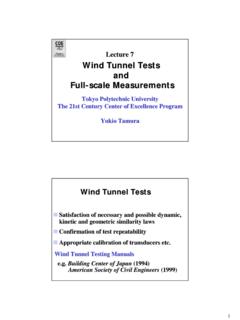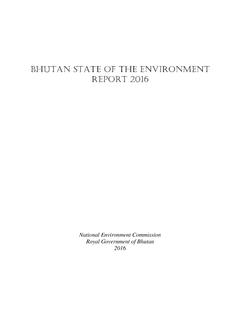Transcription of IN VIETNAM - 東京工芸大学
1 Tokyo Polytechnic University- Graduate School of Engineering- Wind Engineering Research Center DAMAGE CAUSE BY STRONG WIND & WIND LOADS STANDARD FOR BUILDING IN VIETNAM Reported by LE TRUONG GIANG PhD Research Scholar WERC-APEC Wind Hazard Mitigation Centre Graduate School of Engineering Tokyo Polytechnic University 1583,Iiyama, Atsugi, Kanagawa, Japan 243-0297 Email Phone & Facsimile +81-(0)46-242-9540 Date 18- June 2005 i Tokyo Polytechnic University- Graduate School of Engineering- Wind Engineering Research Center CONTENTS Page FOREWORD 1 PART I: DAMAGE CAUSE BY STRONG WIND IN VIETNAM 2 1. OUT LINES OF VIETNAM Geographical Topography Climate The population The GDP The GNI per capita 3 2.
2 natural DISASTER IN VIETNAM The frequency of natural disaster Damage assessment caused by disasters for the 10 recent years Damage assessment caused by each kind of disasters 4 3. TYPHOON IN VIETNAM The frequency of typhoon evens in VIETNAM : The typhoon tracks Typhoon damages in VIETNAM : Recent biggest typhoon Linda- year 1997 in VIETNAM Some examples of typhoon and strong wind damages 9 CONCLUSION 11 PART II: WIND LOAD STANDARD FOR BUILDING IN VIETNAM 12 1. Summary Scope of applications Classification of loads Concepts of (Design load) and (Basic load) Combination of Loads 13 2. Wind Load of TCVN 2727-1995 Outline Wind load definition and scope of application. Determination of basic static pressure of wind load: Equation Determination of Wo Determination of k-value Determination of c-value The c-value for analyzing frame structures The c-value in considering to local pressure zone Determination of basic dynamic pressure value of wind load Case I (f1 > fL) Case II (f1 < fL) Case III (f1< fL < f2) Case IV (fs< fL) Procedure for estimating design wind loads 20 PART III: SITUATION ON BUILDING STRUCTURES, USING FOREIGN STANDARDS AND RENOVATION OF BUILDING CODES IN VIETNAM 21 1.
3 SITUATION ON BUILDING STRUCTURES 21 ii Tokyo Polytechnic University- Graduate School of Engineering- Wind Engineering Research Center Out line of solution for Building Structures in VIETNAM Tendency and prospects on solution of Building Structures in VIETNAM Some pictures of Building structure in last 10 years in VIETNAM . 22 2. SITUATION ON USING FOREIGN STANDARDS AND RENOVATION OF BUILDING CODES. Foreign Standards had used in VIETNAM Legal documents of allowing of Foreign Codes in VIETNAM Renovation of Standards System in Construction Industry. Some example of Using Foreign Standards for Structural Design in VIETNAM 26 CONCLUSION 29 END iii Tokyo Polytechnic University- Graduate School of Engineering- Wind Engineering Research Center FOREWORD The purpose of this report would like to show some basic information of typhoon and wind load standard for wind resistant design in VIETNAM .
4 Beside, other problems of situation of building structures, using foreign standards, and renovation of Building Code in VIETNAM are discussed. 1of 29 Tokyo Polytechnic University- Graduate School of Engineering- Wind Engineering Research Center PART I: DAMAGE CAUSE BY STRONG WIND IN VIETNAM 1. OUT LINES OF VIETNAM Geographical: VIETNAM is stretch of land strengthening along Indochinese peninsula, which is located in South-east Asia.
5 Mainland stretches from 23023 to 08002 north latitude and widens from 102008 to 109028 east longitude. Length counted in straight line from north to south stays at about 1,650 km, width from west to east maximizes at 600 km and minimize at 50 km. Entire territory of VIETNAM includes 329,241 of mainland and 1,000,000 of territorial sea. Inland border of about 3,730 km, shares its border with People Republic of China in the north with border length of 1,150 km, People s Democratic of Laos with length of 1,650 km and United Kingdom of Cambodia with length of 930 km in the west. VIETNAM has sea border in the east, south and southeast, over the China Sea and Thailand gulf is the republic of Philippines, Indonesia, Singapore, Brunei and United State of Malaysia.
6 Fig. 01: Map of VIETNAM in region Fig. 02: Map of VIETNAM topography >>> Topography VIETNAM covers relatively complicated terrain: countless mountains, numerous rivers, stretching and meandering coastline, percentage relation between mountain and plains in mainland area indifferent among regions. In the northern part, the topography is as follows, three sides of the west, east and north are mountains and hills, south side is coastline and the middle is plain, mainly as the Red and Thaibinh River being consolidated for million years. Central part is sloping and narrow, its mountains, plains are closing to its coastline. The part is cut and divided by rivers originating from western mountain ranges flowing into the South China Sea.
7 Along the coastline are small plains. Between sloping mountainsides are narrow and deep valleys. Southern part s topography is even and flat. Cuulong delta is a low-lying region with average height of about 5m above the sea surface. Some regions of this delta as Longxuyen quadrangle, DongThapMuoi and western Hau River are lower than average sea level, therefore, this area of about 1 million hectares affected by floodwater for 2-4 months per year. Climate VIETNAM lies in tropical region, which is meeting place of many atmosphere blocks resulting from continent and Equator Ocean therefore tropical climate of VIETNAM deeply suffers from Asia monsoon regime, mainly as northeast and southeast monsoon. However, northeast monsoon is only strong in northern and north central parts so VIETNAM enjoys two different climate regions.
8 2of 29 Tokyo Polytechnic University- Graduate School of Engineering- Wind Engineering Research Center The north enjoys two typical seasons: hot season is from May to October and cold season is from November to coming April. The South is mainly affected by southeast monsoon with heat and wetness round year. Both parts of the country all enjoy different climate sub-region depending on its features of geography and topography position.
9 There is little difference among regions if temperature is counted averagely as follows Hanoi 240C (City locates in the north of VIETNAM ), Hue 250C (City locates in the midland of VIETNAM ), Hochiminh City 270C (City locates in the south of VIETNAM ), and Dalat 17,60C (City locates in Central highland of VIETNAM ). However, there is large difference among months between the north and the south, different temperature in the north is about 10 to 150C and it is about 2 to 30C in the south. There is about 100 rainy days with total amount of rainfall of 1500 > 2000 mm per year in VIETNAM . The humidity always is more than 70% in all locations in VIETNAM . The population: million (2003- Source: World Bank). The GDP: billion US$ (2003- Source: World Bank).
10 The GNI per capita: US$ (2003- Source: World Bank). 2. natural DISASTER IN VIETNAM The frequency of natural disaster: VIETNAM is one of most disaster-prone countries in the world. The tables below describe the relative frequency of deserter in VIETNAM (Table 1) and Geographic Areas and Economic Zones of disasters (Table 2). Table 1: Disaster relative frequency in VIETNAM can classified as follows [1] High Medium Low Flood, Inundation Hail rain Earthquake Typhoon, tropical depression Landslide Technology Accident Flash flood Forest fire Frost Whirl-Wind Salt water intrusion Drought Table 2.










